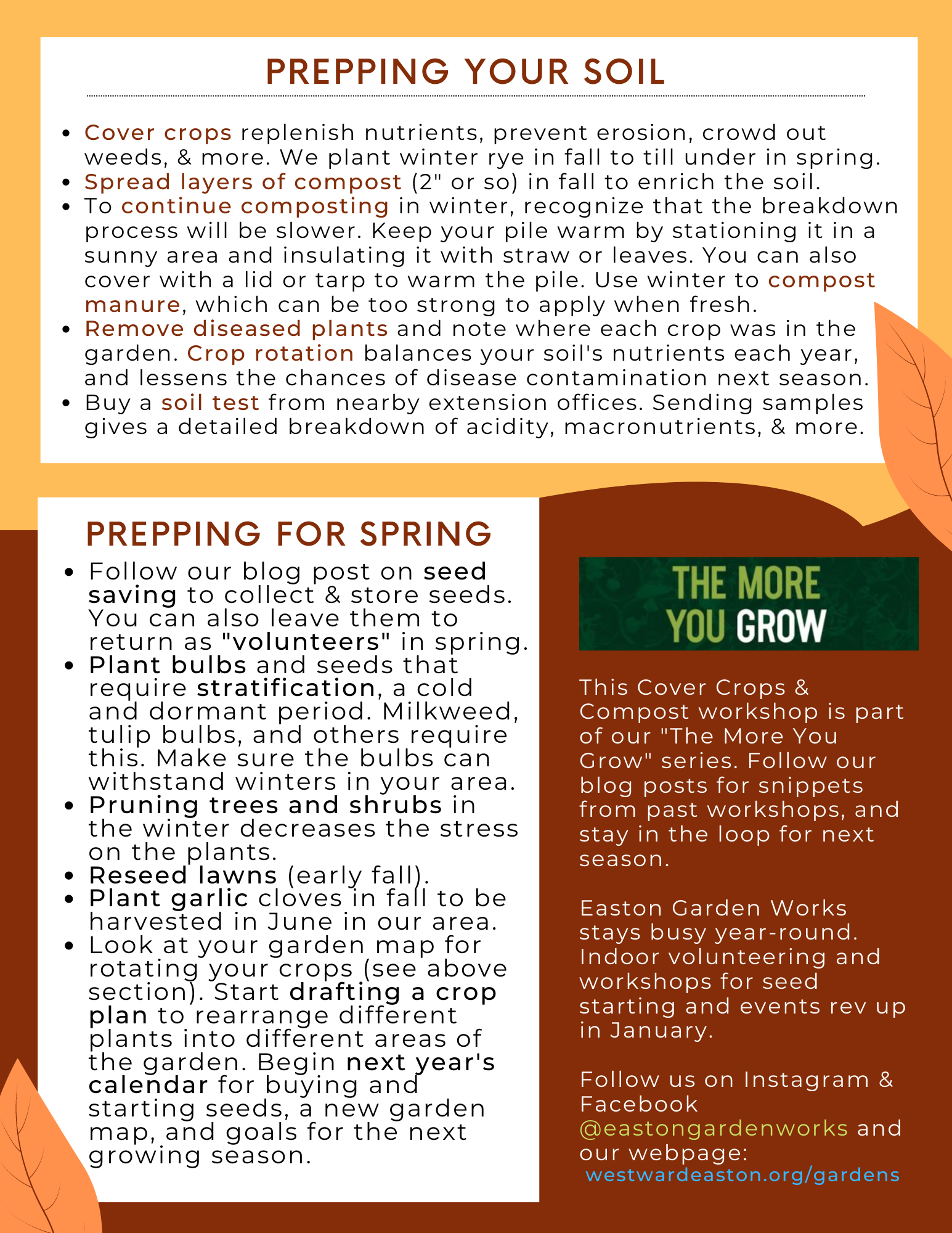More on some of the highlighted fall gardening terms:
- Climate Zone 6b
- USDA plant hardiness zones refer to different growing zones across the US – where the lowest low and highest high temperatures are in any location. You can reference maps to find your zone. Easton, PA is located in Zone 6b, meaning we have a fairly moderate growing season.
- Knowing your zone can help you find vegetable planting guides synced to your location.
- Cold frames
- Cold frames operate as mini greenhouses: they’re low to the ground enclosures with transparent glass or plastic tops to trap in heat. They’re useful to harden off seedlings in early spring, or extend your growing season in fall. You can purchase ready-made cold frames, or upcycle windows and other supplies yourself.
- Cover crops
- Crops sown with the intension of preventing erosion and improving soil health, and not for consumption. Popular cover crops are rye, buckwheat, Sudan grass, and more. They can be tilled under for soil nutrition, but also help keep weeds away and limit soil compaction.
- Crop plan
- Crop plans map out when and where you’ll plant crops over the season. It is useful to start in fall if you have any crops that are overwintering (e.g. mark down where garlic or cover crops were planted). Since not all crops will remain in one place all season (i.e. garlic is harvested in June, leaving you with more space to plant later), crop plans schedule next gardening season which helps you purchase the right seeds and supplies ahead of time.
- We like to utilize the Farmers’ Almanac’s planting calendar guide, which allows you to enter your zip code for personalized frost dates and more.
- Crop rotation
- Moving around your crops will improve soil health (not deplete certain nutrients types of plants take up), plus minimize pests & disease from honing in on your crop from the previous season. Read “crop plan” above on how to map. Pay attention to which plants will swap locations in the gardens with which… you will want different plant families to switch with one another.
- Cuttings
- Certain plants can propagate by cuttings – carefully take a pair of clean scissors/clippers to snip a branch that can grow adventitious roots. Some will require you to identify nodes they will grow from; others will root directly without much finesse.
- Dormancy / overwintering
- Certain plants can weather winter in some locations. This hibernation period slows the plants’ growth, with all energy put into survival. Our kale and parsley overwintered in the garden last year, to “wake up” in spring still producing veggies/herbs. Plants that survive a dormant period can be called ‘overwintered.’
- See “stratification” below to learn about seeds that require a dormant period.
- Macronutrients
- Plants require a set amount of essential macro and micronutrients to grow. Macronutrients include what’s commonly referred to on fertilizers as “NPK” (Nitrogen, Phosphorus, Potassium), among other nutrients. Plants require a much larger amount of these nutrients than those included in micronutrient lists.
- Micronutrients include things like iron, zinc, and others which are still necessary for plant function.
- Perennials
- Plants can be categorized as annual, biennial, or perennial – with perennials referring to those lasting over two years. Even though trees and bushes may be perennials, the term is usually applied to smaller plants.
- Unlike perennials, annuals grow and die in one season and biennials will flower/seed in their second season (after a dormant period). Examples of annuals would be squash or zinnias; and biennials include cabbage and lettuce.
- Planting bulbs, like tulips which will grow perennially, are a great fall activity.
- Pruning
- Pruning, or removing parts of a plant, in the winter is preferable since plants’ energy won’t be used to grow from the severed spot (as they would in summer). This lets them heal properly. We pruned our rose bushes’ dead and unwieldy branches in late fall. Pruning will also help plants grow back thicker.
- Row cover
- “Floating” row cover acts as a blanket hovering over plants that may be tender to frost/cold. Their thickness ranges depending on needs. Can be used in spring and fall. Thinner covers can be used to keep off pests as well.
- Seed saving
- Read more on our Seed Saving blog post on harvesting and storing seed.
- Stratification
- Some seeds require a cold, dormant period which triggers them to grow when the weather warms. Plant seeds like milkweed outside in late fall for a natural stratification period; or, place in your refrigerator to mimic a cold season before planting in spring.
- “Volunteer” plants
- Seeds that scattered without being planted intentionally. Think of cherry tomatoes that dropped all around the garden in summer, and come spring tons of plants might pop up “on their own.” Some people prefer to garden this way, and transplant the seedlings to better spots once organizing their garden in spring.



